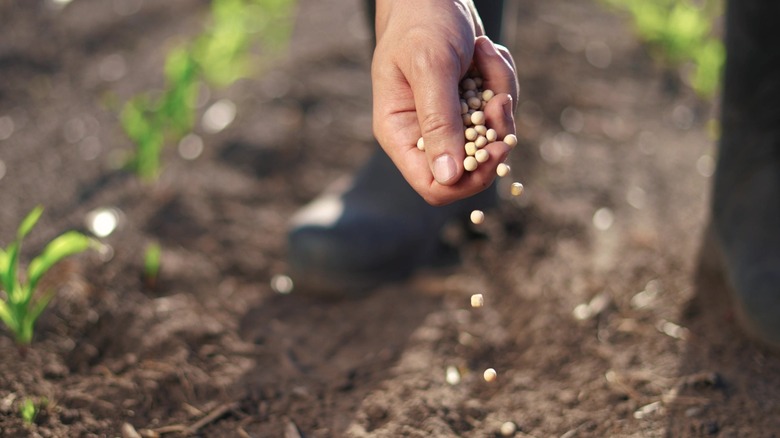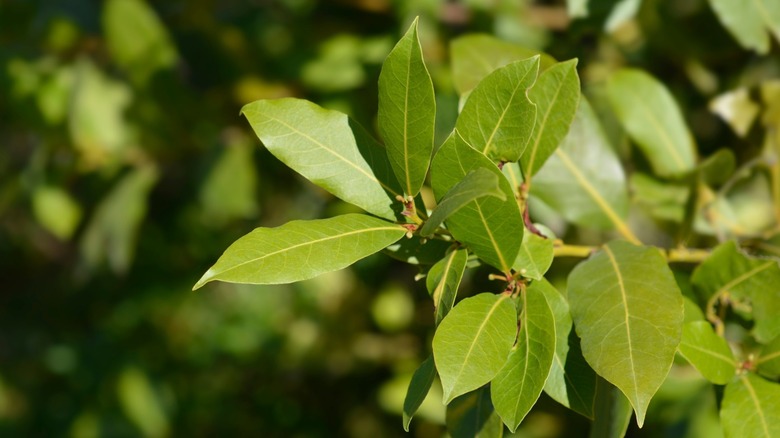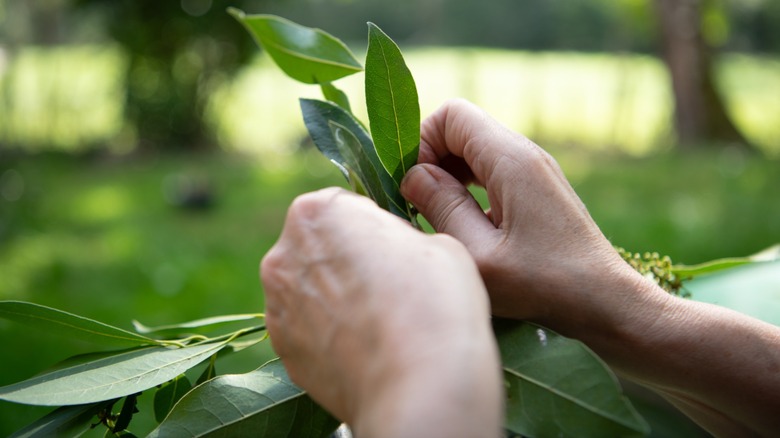The Popular Kitchen Herb That'll Help The Beans In Your Garden Thrive
Companion planting is such a genius hack when you think about it. The fact that you can grow certain plants side by side and actually improve how they thrive is incredible. For instance, adding flowering plants that attract pollinators increases your garden's productivity just as much as it supports a healthier ecosystem. On top of that, the right combination of plants can create both visual and aromatic distractions that confuse pests and naturally protect your plants.
But what's even more fun is that many companion plants have even more utility outside of just being good neighbors to your plants. Some, like cosmos and nasturtiums, make beautiful floral displays. Others, like lavender, are great in potpourri. And there's bay laurel (Laurus nobilis), which you may know as sweet bay or bay leaf, which can go straight from your garden into your kitchen pot.
There's a good chance you have this herb sitting in your spice rack or even growing in your garden. But what you might not know is that the same bay leaf that you probably use to season your pot of beans can also help them thrive when they're growing in your yard by protecting them. Now, while this herb is not the first companion plant that comes to mind, research suggests that when planted near legumes like beans, it's pretty effective at keeping harmful pests like weevils and moths at bay.
Why does bay laurel work well with beans?
Even though beans are among the easiest vegetables to grow, and incredibly helpful to the soil thanks to their nitrogen-fixing abilities, they're still pretty vulnerable to pests. Their tender leaves and pods tend to attract insects that can quickly compromise the health of your plants. However, long before modern research confirmed it, gardeners already understood that aromatic herbs and fragrant ground covers can help deter pests. There's just something about the strong scents they give off that helps create a naturally pest-resistant environment. And bay, as you probably know, is especially fragrant. So when you plant it near your beans, you're essentially adding a natural layer of protection without relying on toxic chemical sprays.
That's because bay leaves are packed with volatile compounds like cineole and eugenol, which have been proven to repel many of the insects that target legumes, especially aphids, bean weevils, and moth larvae. So, in the garden, the spicy, balsamic aroma it releases acts as a natural deterrent. Interestingly, that same pest-repelling quality is what makes bay such a staple in the pantry where it has been used for centuries to keep dry beans and grains safe from bugs.
In addition to masking your beans from pests, as an evergreen shrub or tree, it can provide shade that helps reduce moisture loss around your beans. And that's much appreciated considering that beans love consistent moisture. Beyond that, some gardeners also suspect that growing bay nearby can enhance the flavor of your beans.
How to grow bay as a companion plant?
Bay laurel is a slow-growing, sun-loving herb that'll keep returning to your garden on its own each year. It does best in USDA zones 8 through 11, but if you're in a cooler climate, you can still grow it in a container and overwinter it indoors without any problems. It just doesn't flower as much in a container. But that's not a problem here. When planting bay near your beans, just make sure you leave some space between the two plants. You don't want to shade the beans out or crowd their roots. If you're working with raised beds or containers, bay does well living nearby in its own pot, close enough to release its fragrance, but far enough to avoid blocking light or airflow.
Bay also happens to thrive really well alongside other companions like parsley, rosemary, sage, and thyme, creating a balanced herb garden where each plant supports the others. It's especially handy that many of these same herbs also pair well with beans. Together, these aromatics can help strengthen your garden's natural defense against pests.
And while your bay protects your beans, you can still enjoy it in the kitchen. Just be sure to harvest older, mature leaves and let them dry before using since fresh ones can be a little too bitter. And you can even tuck a dried bay leaf or two into containers of stored beans, and any other grain really, to keep pantry pests away.


